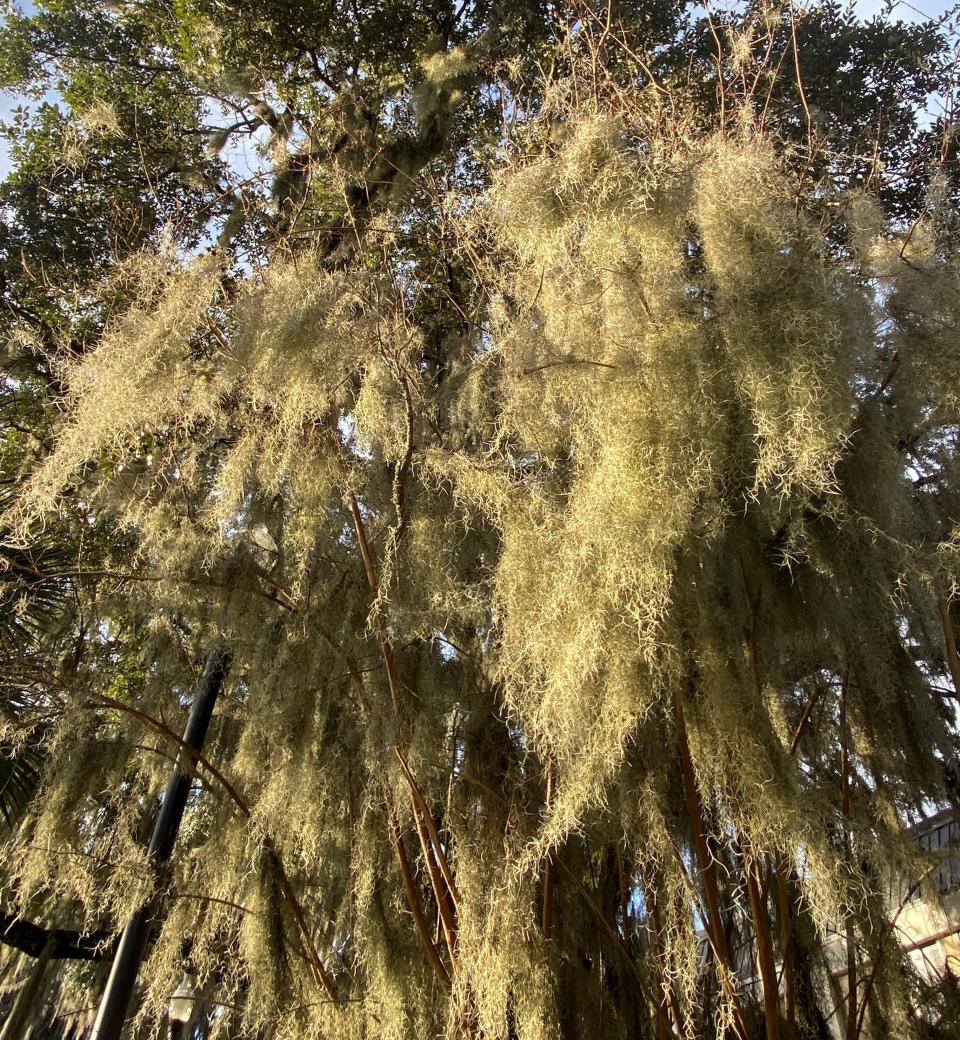Spanish moss is related to the pineapple - and other things you didn't know | ECOVIEWS
Q. Mobile, Charleston and New Orleans are noted for their magnificent live oak trees, many of which have Spanish moss hanging from their limbs. I have several questions about this gray plant.
(1) How does the moss get to the top of the trees? (2) Why do I see it mostly on oak trees and not so much on pines or palmettos? (3) Are the tales true about Spanish moss being full of chiggers? (4) Is the moss harmful to the tree?
A. The iconic plant we call Spanish moss is misnamed in two ways: It has nothing to do with Spain and it is not a true moss. Its closest relative with which most people are familiar is the pineapple.
NICK SABAN COMMEMORATIVE BOOK: Relive Nick Saban’s epic Alabama football coaching career with our special book! Preorder here.
(1) According to Department of Plant Sciences, University of Oxford, the moss has tiny flowers pollinated by equally tiny insects. The windblown seeds can end up in a treetop higher than where they started.
The plant can also propagate vegetatively from strands blown off a hanging clump. These are lightweight, like strings, and may end up on limbs higher up in the same tree or others nearby.

(2) Spanish moss occurs naturally in the southeastern coastal plain from Virginia to Texas. In the scientific journal Ecology, R.E. Garth states that it “does not appear to favor any one host.”
I have seen it thriving most often on oaks, bald cypress and crepe myrtle, which is not even native to the U.S.
Spanish moss is seldom seen on palmettos (sabal palms), probably because the palm fronds are constantly falling off as the tree grows.
I have often wondered why Spanish moss is uncommon on pine trees. Possible explanations given by Garth are because pines shed their lower limbs and because thick thatches of pine needles are a barrier to windblown seeds and moss strands. In addition pine trees, more so than hardwoods, impede rainfall from which the moss gets nutrients.
(3) Spanish moss serves as home to many creatures. But despite oft-repeated tales in the Deep South, I am unaware of any evidence that chiggers, aka redbugs, make it their home.
A scientific article in Southeastern Naturalist by J. Whitaker Jr. and C. Ruckdeschel refutes the chigger indictment.
Spanish moss does, however, serve an important ecological role as housing for a variety of wildlife. Researchers collected samples of Spanish moss and a close relative, ball moss, on Cumberland Island, Georgia, to see what was in residence. They counted a total of 3,297 bugs, including spiders, ants and millipedes, as well as beetle larvae. But sadly, at least for Spanish moss detractors, no chiggers.
Spanish moss looks gray because of a covering of little gray scales on every strand. Whenever I can get a handful while on a field outing, I put it in my mouth for a few seconds and bring it out to show anyone I am with. The strands turn bright green. I have never gotten chiggers when doing this.
(4) Spanish moss usually does not harm a tree because it has no functional root system and therefore does not attach to the tree and remove nutrients. Instead, it obtains its energy by means of chlorophyll like other plants and its nutrients and water from the air and rainfall.
A tree with weak limbs might have problems with moss becoming heavy during rain, and the draping moss might shade lower limbs. But for healthy trees, Spanish moss just makes them look chic.

I recently picked up a clump of Spanish moss blown out of a southern live oak in Beaufort, South Carolina, and found the undamaged nest of a yellow-throated warbler. Inside were three unhatched eggs from the previous summer.
Northern parula warblers are also known to nest in thick clumps of Spanish moss. Although I am told some people do not like the plant hanging around and remove it from their yards, I view it as a wonderful, albeit unusual, habitat to attract a high diversity of wildlife.
Whit Gibbons is professor of zoology and senior biologist at the University of Georgia’s Savannah River Ecology Laboratory. If you have an environmental question or comment, email ecoviews@gmail.com.
This article originally appeared on The Tuscaloosa News: Four questions about Spanish moss answered | ECOVIEWS

